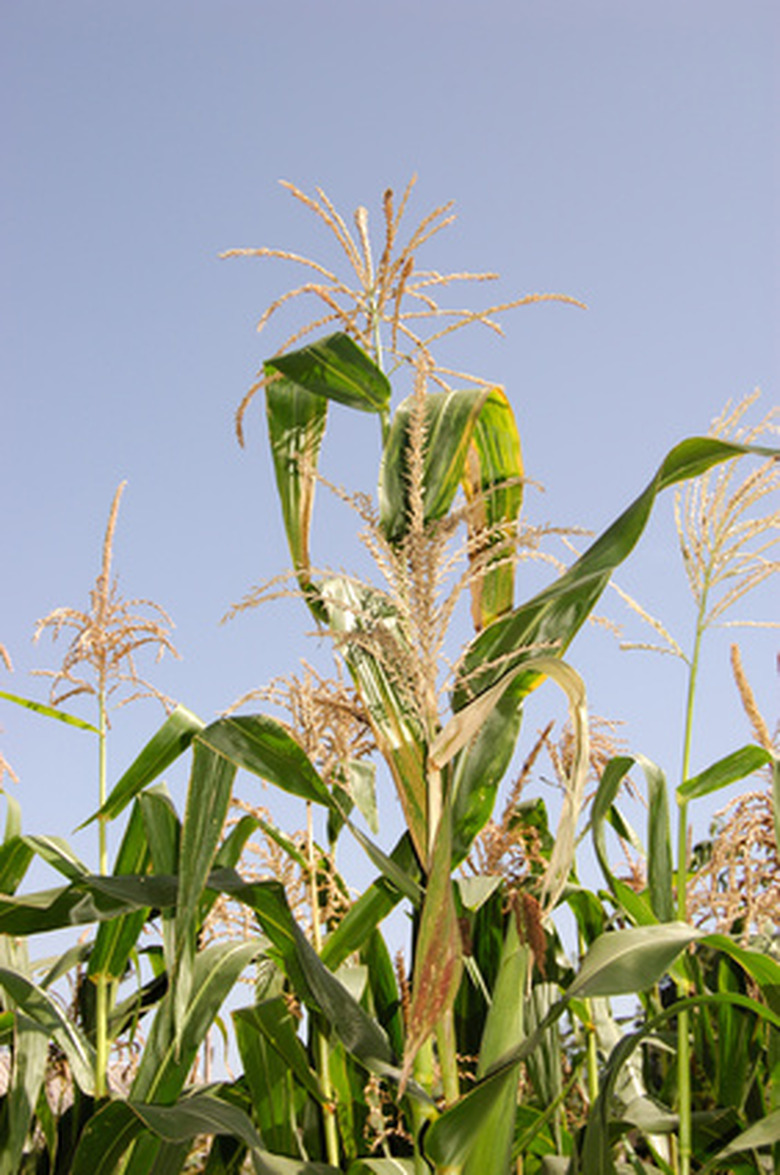The Physical Structure Of A Corn Plant
Native to various parts of Central America, the corn plant (Zea mays) has been grown and bred by humans for centuries, confounding botanists as to their precise native region or genetic identities. Overall, there are four species of wild corn. Corn grows quickly as an annual, completing its entire life cycle in one growing season.
Native to various parts of Central America, the corn plant (Zea mays) has been grown and bred by humans for centuries, confounding botanists as to their precise native region or genetic identities. Overall, there are four species of wild corn. Corn grows quickly as an annual, completing its entire life cycle in one growing season.
Size
Corn plants grow rapidly when provided a moist, fertile soil with ample heat and sunlight. Depending on the specific genetic limitation of any variety of corn, mature plants reach a height anywhere from four to 12 feet in height, and a spread of leaves from two to four feet across. The stem of the corn plant is about one inch in diameter and gradually tapers to a smaller diameter at the top of the plant, where the flower tassel occurs.
Root System
According to I Kisan, an online resource on crops by the government of India, a corn plant produces three types of roots in its lifetime. When the seed sprouts, the seminal roots are the first roots that branch off the first taproot (the radicle) that emerges from the seed. Once a stem forms on the corn plant, the lower nodes on the stem develop roots that grow downward to the soil surface, forming "prop" or adventitious roots that help stabilize the tall, fast-growing stems and leaves in the wind and rains of summer. From the nodes on the stem that is in contact with or just below the soil surface, fibrous, horizontal roots extend outward to facilitate the uptake of nutrients and water. In favorable conditions, these fibrous roots extend up to two feet downward and outward from the corn plant's base.
- Native to various parts of Central America, the corn plant (Zea mays) has been grown and bred by humans for centuries, confounding botanists as to their precise native region or genetic identities.
- Once a stem forms on the corn plant, the lower nodes on the stem develop roots that grow downward to the soil surface, forming "prop" or adventitious roots that help stabilize the tall, fast-growing stems and leaves in the wind and rains of summer.
Plant Tissue Composition
Since corn is a monocot, it develops a structure of cells that have parallel veins, particularly in the foliage. The stiff, rigid tissues of the central stems are rich in sclerenchyma cells that provide the strength and overall structure to the plant. Within the leaves these cells also exist, helping maintain the long, narrow leaf blades horizontally in order to catch the rays of the sun. Vascular tissues, xylem and phloem, are found in the roots, stems and leaves. Xylem tissues flow water, hormones and liquids upward in the plant while downward movement of the same occurs in phloem cells. Cells that actively conduct photosynthesis are primarily oriented in the upper layers of leaves while leaf undersides are full of air space and stomata, which open and close for gas exchange and to release or retain water vapor.
Flowering Structures
Corn plants bear both male and female "flowers." At the top of the corn plant is the male-gendered tassel (technically a panicle inflorescence) that releases pollen grains to the wind. Further down the plant's stem, at the base of a leaf in the middle height form one or occasionally two female ears (a spikelet inflorescence). The silky but sticky hairs that protrude from the ears are attached to an ovary on the immature corn cob (a rachis) within the ear. As pollen falls upon each hair the ovary is pollinated, and fertilized soon thereafter.
- Since corn is a monocot, it develops a structure of cells that have parallel veins, particularly in the foliage.
- At the top of the corn plant is the male-gendered tassel (technically a panicle inflorescence) that releases pollen grains to the wind.
Fruit
The ovaries that line the corn cob swell and ripen the individual embryos inside each. Collectively, all the ovaries on the corn cob swell to create numerous rows of flattened seeds. Eventually the seeds reach a maximum size and dry at the same time the rest of the corn plant degrades and begins to dry and die. As a grain, the fruit of the corn is botanically called a caryopsis, defined as a dry fruit with a seed coat that is fused to the ovary wall.
